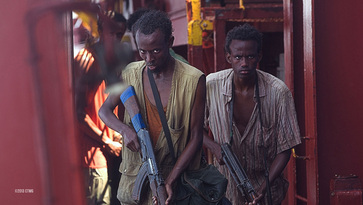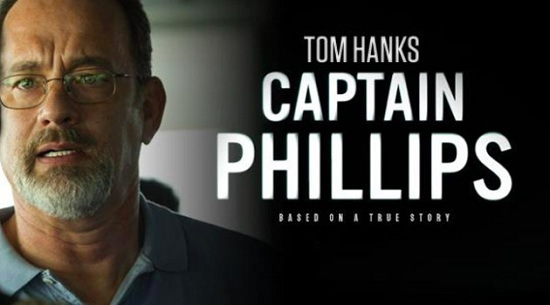Option A: Establish a villain of non-specific European or Asian descent. Avoid killing off any good guys, but if you must, kill only one, and see that she dies protecting 13 others from certain doom. Once all the baddies die, have your leading man stare back in solemn victory, as though wondering whether it was all "worth it." But smash cut to a wedding / family reunion / beers-with-the-boys after a maximum of three seconds. (Examples: Air Force One, Taken, Inception, Apollo 13)
 Barkhad Abdi (Muse) & Barkhad Abdirahman (Bilal)
Barkhad Abdi (Muse) & Barkhad Abdirahman (Bilal) Option B: Establish villains of slightly more specific ethnic descent. Let audiences get to know one or more of these villainous individuals. Kill off a likable character early, then later, kill almost everyone else. End the film silently. Just before the credits, display a snatch of poetry that attempts to make sense of the carnage (but usually doesn't). Roll credits. (Examples: Saving Private Ryan, Black Hawk Down, Zero Dark Thirty, Apocalypse Now)
As such, I spent the first half of Captain Phillips quietly guessing at which way it would go. The first eight minutes were textbook Option A (Look! It's Captain Richard Phillips, the happily-married family man!), but the next 15 were classic B (These Somali teenagers aren't evil! They're just schoolyard kids engaging in competitive banter!). After being jerked back and forth for another hour, I finally gave up on categorizing the film, content to let it end on its own terms. Captain Phillips goes on to provide strong resolution, yet crucially, refuses to pick sides. It ends up being the film's single greatest strength.
Director Paul Greengrass (previously, United 93, The Bourne Ultimatum) not only displays a mature balance between good and evil, but also between predictability and surprise. Nearly every time we might expect a standard plot development (Okay, here's where the hijacking begins! Here's where Phillips is going to escape!), Greengrass pulls back, making us live in each circumstance just a little longer than we might have liked. And yet, Phillips contains no cloak-and-dagger traitors, no Bond-like gadgetry, nor any so-crazy-it-just-might-work scheming. Instead, the film remains raw, uncomfortable, and always unsettling, making the movie decidedly more engrossing than any 2013 summer blockbuster.
If Greengrass' control immediately impresses, Tom Hanks' performance starts slow, then sneaks up fast. During the film's opening act, Hanks' Phillips is likably cranky, at once competent and too-old-for-this-shit. His tired-old-vet shtick works perfectly as he yaps at his 9-to-5 crew, but underwhelms just a tad in the face of the impulsive, gun-waving hijackers. Even for the no-nonsense Phillips, Hanks' cucumber-like cool seems five degrees too cold when the pirates scream for him to follow their commands. Later on, however, Phillips begins to crack. He acts brashly, then seems to think better, then makes another uncharacteristically risky move. Like a ship that's sprung a small leak, Phillips' psychological stress briefly appears manageable, before it splinters all at once, the hapless captain caught up in a flood of desperation. The film's final moments are vintage Tom Hanks: incredibly acted, immediately memorable, and as haunting as anything the actor has done. Like a great Shylock (The Merchant of Venice), Phillips' brief madness retroactively justifies Hanks' otherwise understated performance.
Meanwhile, the largely untested Barkhad Abdi plays Muse, proving a worthy Phillips/Hank adversary both as a character and actor. The self-proclaimed leader of the hijackers, Muse grapples with his own demons—a skinny frame ridiculed by his tribe, a spotty record of success, a tendency toward cowardice. As he bickers with his buddies, ignores reason, or demands to do things himself, he seems no different than an angst-driven American teen, fed up with rules and authority. Unfortunately for Muse, the community proving ground isn't high school football—it's hijacking. If the film's most powerful moment is Phillips' psychological collapse, the second is Muse's wide-eyed fear as half the US Navy surrounds him. He might be a trained killer and determined criminal, but at his core, he's still just a boy looking for recognition.
Late in the film, Phillips jumps back and forth between the Somali hijackers and American Navy SEALs. The former scramble to maintain order, shouting at one another, sobbing, and firing shots erratically. The latter lie motionless, guns trained on targets, expressionless and efficient. The contrast only underscores just how well-trained, disciplined, and methodical the SEALs have learned to be, a determined group of boys now operating as a team of men. There's something oddly satisfying about watching the SEALs alongside the pirates. There's also something profoundly sad.


 RSS Feed
RSS Feed
